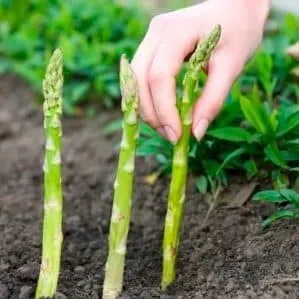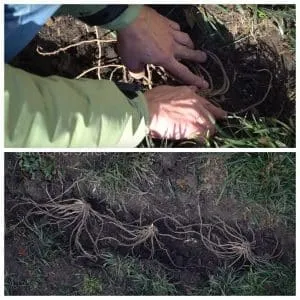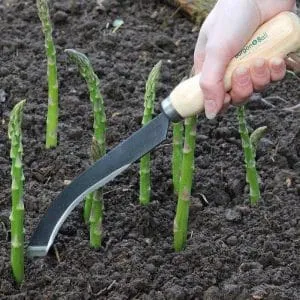Transplanting asparagus is essential for the development and propagation of the crop. The plant can be replanted annually – in autumn for winter preparation.
Why experts recommend transplanting asparagus in autumn, how it affects the plant’s growth and yield, and whether there are strict rules for transplanting – read on to find out.
Table of contents
Why Transplant Asparagus in Autumn
The most common reason for transplanting asparagus is expanding cultivation areas. This high-value vegetable has gained popularity among farmers and gardeners across Europe. Both groups aim to grow as much asparagus as possible – for sale and personal use.
Autumn is the most favourable time to transplant asparagus to a new location, ensuring the first harvest by early spring.
Note. Transplanting asparagus via root division in autumn increases the chances of a successful harvest the following year.
Possible Reasons for Transplanting
Aside from expanding cultivation, there are several other reasons for autumn transplanting:
- excessive shade in the current location;
- adding new asparagus plants;
- replacing old plants with younger ones;
- transplanting into a greenhouse for winter production.
Asparagus is a sun-loving plant that requires an open, sunny spot. Summer growth will indicate whether the location was well chosen. If the plant receives enough light and moisture, it grows quickly and develops a strong root system. If the plant appears weak, yellowish, or stunted, it should be moved to a sunnier bed in autumn.
Asparagus reaches peak productivity in the first ten years. Older plants produce significantly fewer shoots, even under ideal conditions. After this period, they should be replaced with younger ones.
Many gardeners and farmers, aiming for a steady income from asparagus sales, grow the crop in greenhouses. Transplanting in autumn allows for winter harvests.
When to Transplant Asparagus in Autumn
Transplanting times vary across Europe: in southern regions, the process is best done closer to November, while in central and northern areas, late September or early October is ideal.
Agronomists recommend observing the plant’s appearance – transplanting should begin once the foliage turns yellow.
It’s crucial to complete the process 2 – 3 weeks before the first frost.
Preparation
Before transplanting, select the healthiest roots and assess the soil and planting site.
Note. Asparagus thrives in loose, sandy soil rich in organic matter. Poor soil may result in fibrous, flavourless shoots.
Location and Soil
Asparagus can grow in the same spot for up to 20 years, so the location should be chosen carefully – as you would for a tree or shrub.
The ideal site is sunny (or lightly shaded) and undisturbed.
One of the best preceding crops for asparagus is potatoes. Alternatively, beds previously used for other deep-rooted vegetables work well.
Bed preparation steps:
- Select a suitable location.
- Enrich the soil with organic matter: 1 – 2 buckets of manure, compost, or humus per square metre.
- Dig the beds thoroughly.
- Remove all weeds from the asparagus plot.
Potential challenges include heavy clay soil, high acidity, or a high water table.
Solutions:
- To lighten dense soil, mix in coarse sand. The ideal texture is achieved when moist soil no longer clumps.
- To reduce acidity, apply lime, bone meal, or dolomite flour after testing pH levels with litmus paper.
- If groundwater is within 1.5 – 2 metres of the surface, raised beds (10 – 20 cm high) prevent root rot and maintain productivity.
Planting trench dimensions: 30 cm deep × 30 cm wide, with 50 cm between rows.
Important! For autumn planting, mound soil over each root to protect against winter frosts.
Planting Material
Autumn transplanting is done via root division. To ensure strong, healthy plants with high yields, careful selection is key.
Criteria for choosing roots:
- healthy and robust appearance;
- plump and well-developed;
- brownish-grey in colour (elite varieties may have purple or white hues);
Purchase or dig up roots no earlier than a day before planting. Before transplanting, soak them in warm water or compost tea for 15 – 30 minutes.
For division, choose male plants (without seed pods – the red berries), aged 4 – 5 years. Male plants yield significantly more edible shoots. Divide the plant into sections and plant them 40 – 50 cm apart.
Each shoot can become a new plant – carefully separate it from the parent root.
How to Transplant Asparagus Correctly in Autumn
Autumn is the best time for transplanting. While some believe asparagus tolerates summer replanting, spring transplanting delays harvest by a year.
What You’ll Need
After selecting a site and preparing the roots, calculate how many will fit the available space. A square metre should hold no more than 4 – 5 roots, accounting for mature plant spread.
Spacing must be planned to prevent overcrowding.
Steps for autumn transplanting:
- Check the site for fungal spores and weed roots. Both must be removed: weeds can tangle with asparagus roots, and fungi can infect and destroy the crop.
- Ensure the area is sheltered from wind. Wind spreads seeds and spores.
- Loosen the soil.
- Test acidity levels.
Soil pH can vary within a single plot. For accuracy, take multiple samples at 20 – 30 cm depth.
Testing method:
- Mix soil with rainwater to form a slurry.
- Dip litmus paper into the mixture.
- Immediately compare the paper to the pH scale.
- If the colour remains unchanged, the soil is slightly acidic – ideal for asparagus.
Step-by-Step Transplanting Guide
For optimal growth, orient rows southward.
Transplanting process:
- Dig a trench at least 30 cm deep.
- Flatten the base of the trench.
- If the soil is compacted, loosen it.
- Add a 10 cm layer of compost.
- Mound excavated soil over the compost (the peak should stay below ground level).
- Place seedlings along the mound, 40 – 50 cm apart.
- Spread roots over the mound’s slopes.
- Cover with soil and level the surface.
- Water generously and mulch.
Post-Transplant Care
After autumn transplanting, asparagus needs watering – less frequent than in spring and summer, but consistent moisture is essential.
Water every 4 – 7 days (3 L per plant) until frost. Loosen soil after each watering to prevent waterlogging and mould.
No fertiliser is needed after autumn transplanting – the initial nutrients suffice until spring.
The first organic feed (1 kg manure per 5 L water) is applied in mid-May – 2 L per plant.
Four seasonal feeds are recommended. Use chicken manure or superphosphate.
Keep rows weed-free. Weeds reduce yield and invite pests and diseases.
To block external weeds, bury a metal or slate barrier (50 cm deep) along plot edges.
Note! Regular weeding and soil aeration are crucial for high yields.
After autumn transplanting, mound soil over plants for winter protection.
Conclusion
Despite asparagus’s global popularity, its cultivation in Europe is still evolving, and many growers are yet to master its agronomy.
High yields depend on simple transplanting, watering, and fertilising practices. Choose sunny, sheltered sites, test soil pH, apply nutrients timely, and control weeds.
Growing asparagus follows the same principles as other crops: maintain clean beds, proper moisture, and temperature. These basics ensure success, whether cultivating small gardens or large fields.







